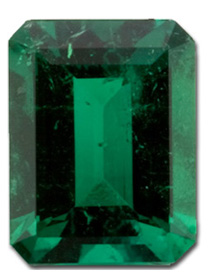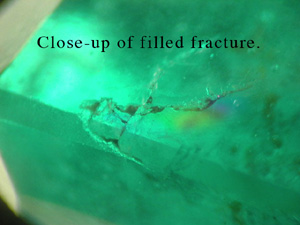Enhanced Emeralds —
The Clever Cover-up
When it comes to gems, "enhanced" sounds good, but that word signals a cover-up. Here’s the skinny on the good, the bad, and the ugly of emerald enhancement.
Emerald is one of the four "precious gems" (along with diamond, ruby and sapphire), so most people assume emeralds are expensive. Well, some are and some aren’t.
Emeralds, lovely as they are, often have inclusions or fractures. That’s the nature of this gem material. In fact, a natural emerald with only minimal fissures is so rare that it’s worth far more than a diamond of similar carat weight and clarity.
 |
 |
2.38 carat Emerald-Cut Diamond $21,000 |
2.03 carat Emerald-Cut Emerald $30,000 |
Many good-quality emeralds used in jewelry have minor surface flaws. Oiling, a routine practice that’s been done for hundreds of years, improves the appearance of the stones and does not affect their value or durability.
Newer technologies, however, make it possible to sell extremely flawed, low-quality emeralds that previously would have had to be discarded. Without "clarity enhancement," any observer would see these stones as defective, unattractive, even ugly. But after enhancement, they look good to all but a trained gemologist observing them under high magnification.
Problems with the enhancement may not show up until much later. Meanwhile, emeralds of poorer and poorer quality are finding their way into jewelry.
Fracture Filling
Because emerald is so likely to have fractures, suppliers often fill the fractures with non-gem material. This masks the flaws and improves the appearance of the stone, making it more salable. Literally hundreds of proprietary formulas are used to fill fractures and fissures. The transformation of a stone’s appearance can be dramatic.

Caution! For the insurer, as well as the consumer, there are serious issues with fracture filling:
- Fracture-filling is not considered a permanent treatment.
Fillers are likely to break down under cleaning with steam or ultrasound, they can be harmed by heat from a jeweler’s torch if the stone is reset, or they may simply break down over time. A filling may turn dark or white or simply deteriorate, leaving the fractured stone in its original condition. In some cases, fillers may even expand over time, causing the stones to shatter.
Breakdown of a filling is not damage for which the insurer is liable. It is crucial that fracture filling be noted on the appraisal.
- Fracture-filled stones are worth considerably less than unenhanced emeralds of similar size. It’s essential that the treatment be disclosed at every step in the selling chain.

 4.90 carat
4.90 carat
fracture-filled Emerald
$2,0002.03 carat
untreated Emerald
$30,000 - Fracture filling may be done to emeralds that have only slight fractures, or it may be done to stones that are riddled with fractures—unattractive, low-quality stones that in their natural "un-enhanced" state no one would want. Even the disclosure of fracture filling does not tell the insurer (or the buyer) how severely the stoned is fractured.

- Fractures in an emerald not only make the stone less beautiful but also weaken it. An emerald that has its fractures filled in will look better to the naked eye, but it’s still a brittle stone, susceptible to breakage.
Caution! Fractures in emerald amount to inherent vice. Filling the fractures only conceals them. The wisest course would be not to insure fracture-filled emeralds at all.
Eternity Emeralds
One company has developed a filler that it claims will not fade, discolor, deteriorate or dry out under normal wear and tear or under the rigors of cleaning. It sells the gems under the brand name Eternity Natural Emerald. The company states that all of its emeralds are either unenhanced or are enhanced with its ExCel process.
The durability of the ExCel filling has not been independently verified, but all Eternity emeralds come with a written lifetime guarantee. The guarantee states that, if the enhancement fades, dissolves or deteriorates, the company will re-enhance the gem or replace it with an enhanced gem of equal or greater value.
The guarantee "specifically excludes cracking, natural defects or other damage to the gemstone."
Important notes:
- Eternity guarantees only the filling, not the quality of the stone. As noted in the section above, an enhanced emerald is one that is fractured to begin with—that’s why it needs clarity enhancing. A highly fractured stone is weak and susceptible to breakage, whether or not the fractures are filled.
- Eternity sells fracture-filled emeralds. This name on an appraisal or other documents indicates a fracture-filled stone, unless the appraisal specifically states that the gem is unenhanced, or untreated.
- For any damage claim on emerald jewelry, have the stone examined by a trained gemologist in a gem lab to be sure the damage is not due to breakdown of the fracture-filling treatment.
Perma-Filled Rough
Traditional fracture filling is done on emerald that is already cut to its final shape. Some labs have begun a new practice: using a material called Perma to fill fractures in the emerald rough before it is cut into gems.
This practice vastly increases the output from a piece of rough because it allows gems to be cut from material that would otherwise have to be discarded as too fractured. Some gem merchants have seen emeralds held together only by Perma filler as a sort of glue.
Caution! If an emerald is cut from Perma-filled rough, when the filling breaks down the gem will simply fall apart.
One expert in emerald fillers handled an emerald that weighed close to 40 carats. He noted that repolishing the stone opens up fissures. "If I go and clean this stone," he said, "his $135,000 emerald will fall into four pieces."
Perma is commonly used to enhance finished emeralds, and honest jewelers will readily disclose the treatment. However, labs that are using Perma to fill rough gem material (rather than finished gems) will still say "enhanced with Perma." This amounts to less that full disclosure, since jewelers—and purchasers and insurers—are not told whether the enhancement was done to the rough or to the finished gem.
Caution! A trained gemologist can detect the extent of fracturing and filling, but most jewelers are not trained gemologists and may not even examine the goods they sell.
FOR AGENTS & UNDERWRITERS
Clarity enhancement has a serious effect on valuation. A fractured-filled emerald is worth significantly less than one of comparable appearance that is not "enhanced."
There is always the danger that gem treatments will not be disclosed—by the supplier, the dealer, the jewelry manufacturer, the retailer, or the consumer—either out of ignorance or as deliberate fraud. The insurer is at the end of this chain and could wind up grossly overpaying a claim.
For all emeralds, be sure the appraisal either explicitly states that the stone is untreated or lists the treatments, such as fracture filling.
Not all jewelers are trained gemologists with proper gemological equipment. Not all jewelers even examine the gems they sell. For high-priced emerald jewelry, be sure the appraisal is written by a jeweler who is
- a GIA Graduate Gemologist (GG), who examines the jewelry in a gem lab;
- a Certified Insurance Appraiser (CIA™), who writes appraisals on JISO 78/79, the insurance industry’s standard.
Not all jewelers are competent to appraise colored gemstones. For emerald jewelry, be sure the appraiser — besides being a GG and a CIA
- regularly deals in colored-gem jewelry. Such an appraiser will be able to recognize specific enhancements and understand their effect on valuation. He’ll also be aware of current trends and scams and be on the lookout for them.
Fracture filling is done to visually conceal flaws in the gem. A gem with fractures, whether filled or not, is weak and susceptible to damage. An emerald cut from Perma-filled rough could fall to pieces. Such material is an accident waiting to happen.
Would we knowingly insure something with a manufacturer’s defect?
It is our recommendation that fracture-filled emeralds not be insured at all because the fractures constitute inherent vice.
FOR ADJUSTERS
Clarity-enhanced stones are worth far less than unenhanced emeralds of similar appearance. Use every means possible to determine whether or not the emerald has been fracture filled.
Study the appraisal for such words as treated, enhanced, clarity enhanced, or fracture filled. This is crucial information when you are pricing a replacement.
Compare the sales receipt with the appraisal. If there is a great discrepancy between selling price and valuation, the selling price probably reflects value more accurately. If the sale price seems "too low," it’s possible that the gem was fracture-filled or was synthetic. A jewelry insurance expert may help in determining this.
If a claim is made for damage, ALWAYS have the damaged jewelry examined in a gem lab by a graduate gemologist, preferably one who is also a CIA. The exam
- will verify the quality of the jewelry;
- may supply information missing from the appraisal;
- may reveal that the "damage" is not damage at all;
- may show the damage resulted from breakdown of fracture-fill material.
If the emerald was fracture-filled, look closely at inherent vice exclusion on the policy.
Ask the policyholder whether the jewelry has recently been cleaned or the gem reset. Fracture-fill materials often discolor or break down under the stress of heat or chemicals, and the vibrations of ultrasonic cleaning may actually cause a fractured stone to break. Such breakage is not damage for which the insurer is liable.
©2000-2025, JCRS Inland Marine Solutions, Inc. All Rights Reserved. www.jcrs.com

